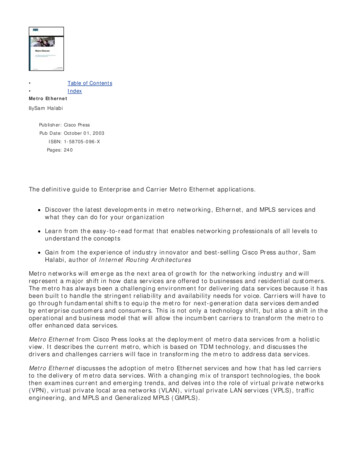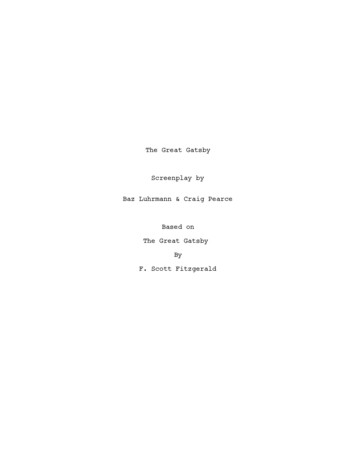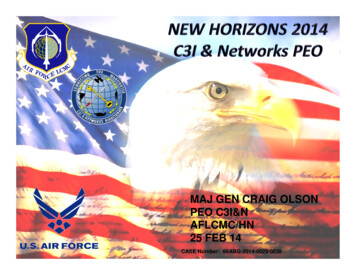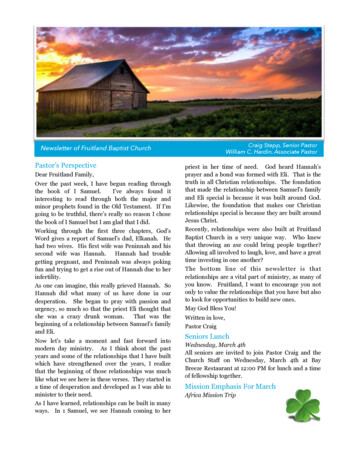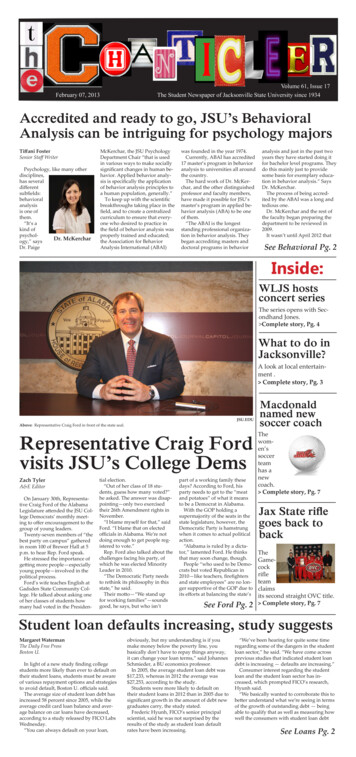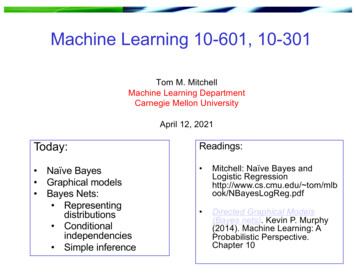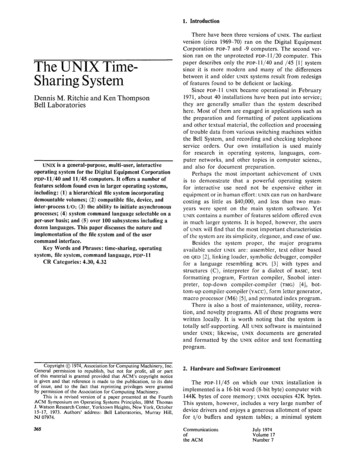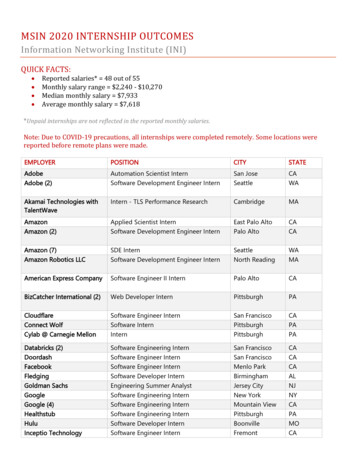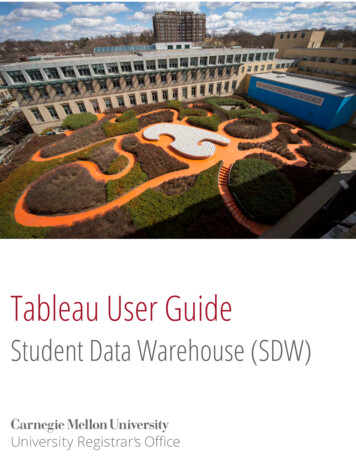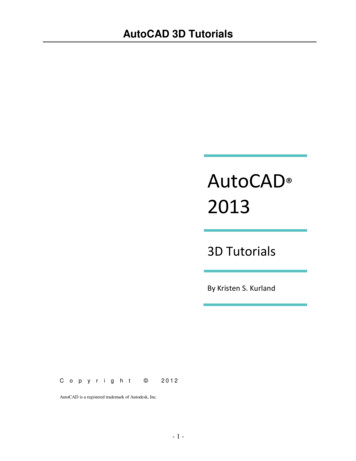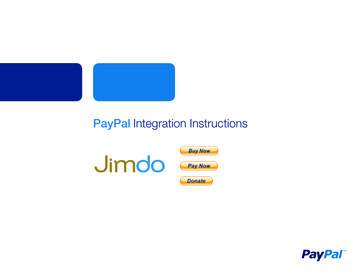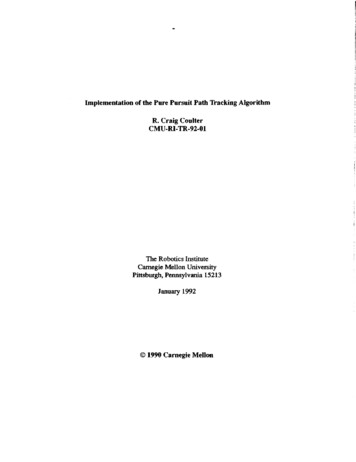
Transcription
Implementation of the Pure Pursuit Path 'hcking AlgorithmR. Craig ConlterCMU-RI-TR-92-01The Robotics InstituteCamegie Mellon UniversityPittsburgh, Pennsylvania 15213January 19920 1990 Carnegie Mellon
Table of ContentsPursuit Algorithm.33345566Properties of the Algorithm.Effects of Changing the Lookahead Distance.Non Unique Lookahead for a Given Pam .DescriptiOlLTheoretical Derivation.Implementation.Path RepresentatioaCommunication and Path Management.7
List of FiguresFigure 1. Geometry of the AlgorithmFigure 2. Gaining the Patb.Figure 3.Maintaining the Patb4.7.7.
AbstractThe main purpose of this technical report is to describe in detail the implementation of the purepursuit path tracking algorithm. Given the general success of the algorithm over the past few years,it seems likely that it will be used again in land-based navigation problems. This report alsoincludes a geometric derivation of the method, and presents some insights into the performance ofthe algorithm as a function of its parameters.
31.0 IntroductionThe pure pursuit algorithm has been used at the Robotics Institute for a number of years. First onthe Terragator, then on the NavLab and more recently, on the NavLab I1 (also called theHMMWV). Amidic11 implemented and tested thii algorithm under a variety of conditions, andfound it to show the greatest promise as a general purpose tracking algorithm.The main purpose of this technical report is to describe in detail the implementation of the purepursuit algorithm. Given the general success of the algorithm over the past few years, it seemslikely that it will be used again in land based navigation problems. This report also includes ageometric derivation of the method, and presents some insights into the performance of thealgorithm as a function of its parameters.1.1HlstoryThe pure pursuit algorithm was originally devised as a method for calculating the arc necessary toget a robot back onto a path. This first application of the method came with the Terragator, a sixwheeled skid steered robot that was used for outdoor vision experimentation in the early 80’s.Thestandard references for the original derivations of the w o k go to Wallace[3].When the work on the Terragator moved to the then new NavLab, the arc commanding algorithmfollowed. Throughout the NavLab pmject a number of path tracking algorithms were proposed andimplemented, including the Quintic Polynomial approach and a “Control Theory” approach.Testing of all of these algorithms showed that the Pure Pursuit method was the most robust andreliable method going. Amidi[l J’s masters thesis contains the results of his comparison of the threeaforementioned methods.After the N a v h b II (ak.a. the HMMWV) was built we opted to use the pure pursuit tracker, basedon its reliable performance. Our software team was busy developing other pieces of code for theplanning, the dynamics, and the perception modules and we really didn’t want to build a trackerfrom scratch. We copied some old pure pursuit tracking code onto the NavLab 11and got it workingand used it pretty steadily for about three months. We were a IittIe disappointed in its performance,but found it acceptable. It would track most of the paths thatwe gave it, but occasionally lost a pathcompletely.The code that we had copied was experimental left-overs from the last NavLab project.It containedmany tracking algorithms, one of which was pure pursuit. We had a few bugs in our system as awhole and couldn’t discount the tracker as a possible culprit, so it fell to me to rewrite a tracker,with pure pursuit as the algorithm of choice. In performing this service I discovered that the codethat we had been running had been executing with two separately defined lookaheaddistances.(You should read the nest chapter for the definition and discussion of this parameter.)Parts of the code were running with a lookahead of 18 meters, and other parts were running with alookahead of 4.5 meters. The reason that I bring this point up is that it amazed our group that thetracker had performed as well as it did given this fairly major error. We gained some additionalrespect for an algorithm that was robust enough to work when “purposely” maimed.
41.2.DescrlptlonWhat is pure pursuit?Pure pursuit is a tracking algorithm that works by calculating the curvature that will move a vehiclefrom its current position to some goal position. The whole point of the algorithm is to choose a goalposition that is some distance ahead of the vehicle on the path. The name pure pursuit comes fromthe analogy that we use to describe the method. We tend to think of the vehicle as chasing a pointon the path some distance ahead of it - it is pursuing that moving point. That analogy is often usedto compare this method to the way humans drive. We tend to look some distance in front of the carand head toward that spot. This lookahead distance changes as we drive to reflect the twist of theroad and vision occlusions.2.0 Theoretical DerivationThe pure pursuit approach is a method of geometrically determining the curvature that will drivethe vehicle to a chosen path point, termed the goal point. This goal point is a point on the path thatis one lookahmd disrunce from the current vehicle position. An arc that joins the current point andthe goal point is constructed. The chord length of this arc is the lookahead distance, and acts as thethird constraint in determining a unique arc that joins the two points. Consider the lookaheaddistance to be analogous to the distance to a spot in front of a car that a human driver might looktoward to track the roadway.Consider Figure 1. The vehicle is pictured, with the axes of the vehicle’s coordinate system drawn.The X axis passes through the rear axel of the vehicle. Shin[2] shows that propulsion and steeringare geometrically decoupled ifthe vehicle’s coordinate system is placed at the rear differential withthe x-axis colinear to the rear axel.The point (x,y), which is one lookahead distance 1 from the origin, is also shown.The point (x,y)is constrained to be on the path. The objective is to calculate the curvature of the arc that joins theorigin to (x,y) and whose chord length is 1.
5YIGeometry of the Algorithm.Figure 1.The following two equations hold. The first is from the geometry of the smaller right triangle inFigure 1. The second from the summing of line segments on the x axis.x y Ix d r*(2.1)(2.2)4 u a t i w (2.1) descrik the circle of radius 1abwt the origin. TMs Is the locos of possible goal points for thevetucle.Equation (2.2) describes the relatioashipbetween the d u s of the arc h t joins the origin and the goal point,aod the x offsetofthe goal point from the vehicle. Tbk equation simply states that the radius of tbc arc and the xoBet are independent and differ by dThe next series of equations relate the curvature of the arc to the lookahead distance. The algebrais stmightforward and requires no further explanation.
6d r--xr2-22rx -x2 yZ r2The curvature has been related to the x offset of the goal point fcm the origin by the inverse squareof the lookahead distance 1. There is some similarity in form to aproportional controller where thegain is 2 times the inverse square of 1. However the “error” in this form is the x offset of a pointahead of the vehicle.3.0 ImplementationThe method itself is fairly straightforward, FIS is the implementation. The only real implementationproblems lie in deciding how to deal with the path information (communication, graphics,updatingthe path with new information from the planner), and even that isn’t too bad.3.1. Path RepresentanonA path is represented as a set of discrete points. (It has to be to be stored in memory.) Typically apath point is of some PATH-TYPE that i s a smct containing the following information:---* x location in global coordinates.y location in global c o a t e s .heading in global coordinates.curvature of the path at this point.* distance (dong a suaight line) of tbis point from the beginning of the path.3.2. Communlcatlonand Path MenagememThe tracker usually runs on one machine while the planner runs on another. The idea is that duringa navigation cycle the planner finds a path segment through the newly perceived terrain.
7Meanwhile the tracker is driving the vehicle along the old path. When the planner completes itspan of the cycle it must send the new path to the tracker. This new path probably padally overlapsthe old path, so the planner must also tell the tracker what p a t of the old path can be overwrittenwith new information. Specific data management and communications techniques are beyond thescope of this technical report, the intent here is only to note that they are necessary and non-trivialportions of a real tracker implementation.We must also note in this section that some provisionmust be made for interfacing the tracker withthe sensor modules on the vehicle. In our implementation the tracker has an interface to a centralvehicle controller which can inform the tracker of the current vehicle pose. The tracker can sendits driving requests to this central controller for vehicle execution.Pursuit AlgorlthmThe implementation of the pure pursuit algorithm itself is fairly straightforward. The pure pursuitalgorithm can be outlined as follows:3.3.-Determine the anent location of the vehicle.-Find the path point closest to the vehicle.* Find the goal point- Transform the goal pohl to vehicle coordinates.*Calculate the curvature and request the vehicle to set the steering to that curvature.-Update the vehicle’s position.1) Determine the current location of the vehicle. Both the HMMWV and NavLab have a centralvehicle controiler that provides functions which report the vehicle’s current position as(x,y,heading). The position is reponed with respect to the vehicle’s position at initialization time.This original position is the global reference frame for the run.2 ) Find the path point closest to the vehicle. In the geometric derivation it was stated that the goalpoint would be within one lookahead distane of the vehicle. It is possible that there are multiplepoints one lookahead distance from the vehicle’s current location. The vehicle should steer towardthe closest point one lookahead distance from its current location. Therefore, the path point closestto the vehicle will first be found, and the search for a point 1 lookahead distance away &om thevehicle will start at this point and commence up the path.3) Find the goal point. The goal point is found by moving up the path and calculating the distancebetween that path point and the vehicle’s current location. Path point locations are recorded in theglobal frame; this calculation is done in global coordinates.4) 7hnSform the goalpoint to vehicle coordimztes. Once the goal point has been found, it must betransformed to the vehicle’s local coordinates. The geomemc derivation for the curvature was donein vehicle coordinates and curvature commands to the vehicle make sense in vehicle. coordinates.
85 ) Calculate the curvature. Using the curvature equation derived in the last section, calculate thedesired vehicle curvature. The curvature is transformed into steering wheel angle by the vehicle’son board controller.6 ) Update the vehicle’s posirion.During simulation, it is necessary to determine what effects thecommand has upon the vehicle’s position and heading.4.0 Properties of the Algorithm.4.1.Effects of Changlng the Lookahead MstanceThere is one parameter in the pure pursuit algorithm, the lookahead distance. The effects ofchanging the lookahead distance must be considered within the context of one of two problems:1) Regaining a path; i.e. the vehicle is a “large” distance from the path and must attain thepath.2 ) Maintaining the path, i.e. the vehicle is on the path and wants to remain on the path.The effects of changing the parameter in the first problem are easy to imagine using the analogy tohuman driving. Longer lookahead distances tend to converge to the path more gradually and withless oscillation. The response of the pure pursuit tracker looks similar to the step response of asecond order dynamic system (Figure 2.). and the value of 1 tends to act as a damping factor.II smallPathA/1 largeRguIe 2.Regaining &e path.In the second problem, the longer the lookahead distance, the less ‘‘curvy’’ of a path that can befollowed. The algorithm is calculating a curvature so that the vehicle can drive an arc. If the pathbetween the vehicle and the goal point is sufficiently ‘‘curvy’’ then there is no single arc that joinsthe two points; any driven arc will induce error.Non Unlque Lookaheadfor a Glven Path Curvature.The path tracking problem that we most often have to address is that of staying on a path, ratherthan getting onto a path. We felt that it would be very useful to find a closed fom relationshipbetween the curvatm of the path and an optimal lookahead distance. We sought to find a solutionfor the optimal lookahead for a circle of arbitrmy curvature. Once this relationship was found, thenthe lookahead could be changed as the curvature of the path changes.4.2Finding a solution to this problem implies that a one to one relationship between the lookahead
9distance and the curvature exists. The circle in Figure 3 is a path of constant curvature and thereforeshould have one lookahead distance that can be used for path following.Vehiclestart point(0.0)Figure 3.Maintaiuing the path.An isosceles triangle within the circle shows the lookahead distance as the base of the triangleextending from the staxting point to the goal point, the sides of the triangle are simply the circleradius. A lookahead distance that can fonn this isosceles triangle will satisfy the conditions oncurvature stated earlier and therefore define the curvature of this circle. But it can be easily be seenin the diagram that many lookahead distances wi
The chord length of this arc is the lookahead distance, and acts as the third constraint in determining a unique arc that joins the two points. Consider the lookahead distance to be analogous to the distance to a spot in front of a car that a human driver might look toward to track the roadway. Consider Figure 1. The vehicle is pictured, with the axes of the vehicle’s coordinate system drawn .
